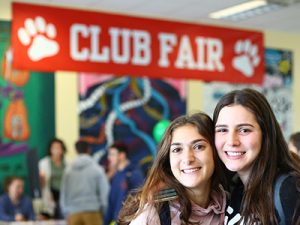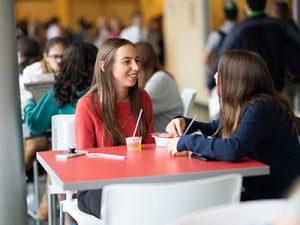Visual Arts Track Curriculum
Freshman Year: Foundations of Design
Semester 1: Foundations of 2-D Design
Students are introduced to the foundational elements of design: line, shape, color, value, form, space, and texture, as well as the principles of design: balance, unity, emphasis, proportion, rhythm, and movement. They work with a variety of 2-D media such as charcoal, pencil, color pencil, pastel, and watercolor. Projects include still life rendering as well as assignments in fashion illustration, textile design, and graphic design.
Semester 2: Foundations of 3-D Design
Students learn how to plan, design, and construct a variety of three dimensional objects, while gaining an appreciation for the application of the elements and principles of design within the world and with multicultural and art historical themes. A variety of materials are used, such as fabric, clay, paper, and 3D printing.
Sophomore Year: Line, Value, Shape, Texture, and Space
Semester 1: Drawing Studio
Students develop the fundamentals introduced in 2-D design, with attention to creative ideas and problem solving. Emphasis is on drawing from life, figure drawing, and portraiture, “plein air” landscape drawing, and abstraction as it relates to mark-making and texture.
Semester 2: Printmaking and Graphic Design
Students learn the history, techniques, and process of creating images from a prepared surface and are introduced to linocuts, woodcuts, monotype, and collagraph printmaking. The process of printmaking bridges the gap between graphic and fine art forms. Design assignments include tutorials in using Adobe Photoshop and Illustrator.
Junior Year:
Option A: Using Color to create Balance, Unity, Rhythm & Movement
Semester 1: Painting Studio
Students develop artistic painting skills, knowledge, visual observation, and appreciation as they explore a variety of painting media such as watercolor, acrylic, oil sticks, and mixed media. The course emphasizes the cultivation of personal style and aesthetic understanding through student research, study, and oral presentations of historical and contemporary artists.
Semester 2: Modern Art and Design Understanding
Students have the opportunity to analyze, create, interpret, and reflect on works of modern art this semester. Their projects force them to think deeper and create more conceptual works of art. They will then study a variety of works of art that exemplify good design and use them to formulate and formalize their own personal design style. Their final project involves research and planning, branding, designing their own website, and print media for their portfolios and to promote themselves as artists.
Senior Year:
Semester 1: College Portfolios/Breadth section of AP
Students begin senior year with a student review of their online portfolio. Once evaluated, specific college portfolio requirements and recommendations are implemented. Students are afforded an in-depth directed study which guides them in their own art production and encourages the exploration of diverse art styles.
Semester 2: Concentration section of AP
Students prepare a 2-D design or 3-D design portfolio to submit for the Advanced Placement studio art exam evaluated by the College Board. Students then develop and execute a body of work that reflects a personal theme, visual interest, or problem. This concentration grows out of the student’s ideas and demonstrates growth and discovery through a number of conceptually-related works of art. Students’ art is evaluated not only on the work presented, but also on the visual evidence of the student’s thinking, selected method of work, and development of art throughout the semester.
Exhibitions and Competitions
Students contribute artwork for various displays throughout the school. Additionally, art students have the opportunity to assist in designing and painting stage sets for drama and musical productions. Students are given the opportunity to meet professional artists who are invited into the class to speak and demonstrate various techniques. Professional photographers, studio potters, gallery owners, painters, and graphic designers are just a few examples of visitors. Junior and senior classes are also visited by college representatives from various art schools and art departments. Art students are encouraged to apply to various art competitions throughout the year and opportunities are offered to create posters, logos, and other marketing materials for local businesses and organizations.





